Detailed Managerial Economics Assignment Solution for MEC604 Course
VerifiedAdded on 2023/06/10
|29
|5784
|99
Homework Assignment
AI Summary
This document presents a comprehensive solution to a Managerial Economics assignment, covering key concepts such as financial and economic costs, profit maximization, price elasticity of demand, and price discrimination. The assignment delves into the law of diminishing returns, short-run cost curves, and economies of scale, providing detailed explanations and calculations. It analyzes market demand determinants, optimal sale price determination, and conditions for effective price discrimination, with examples from the airline industry. The solution includes formulas and examples to illustrate these economic principles, offering a thorough understanding of the subject matter. The assignment is divided into two parts, A and B, and covers topics ranging from cost analysis to market dynamics and production functions. The assignment provides a clear understanding of managerial economics.
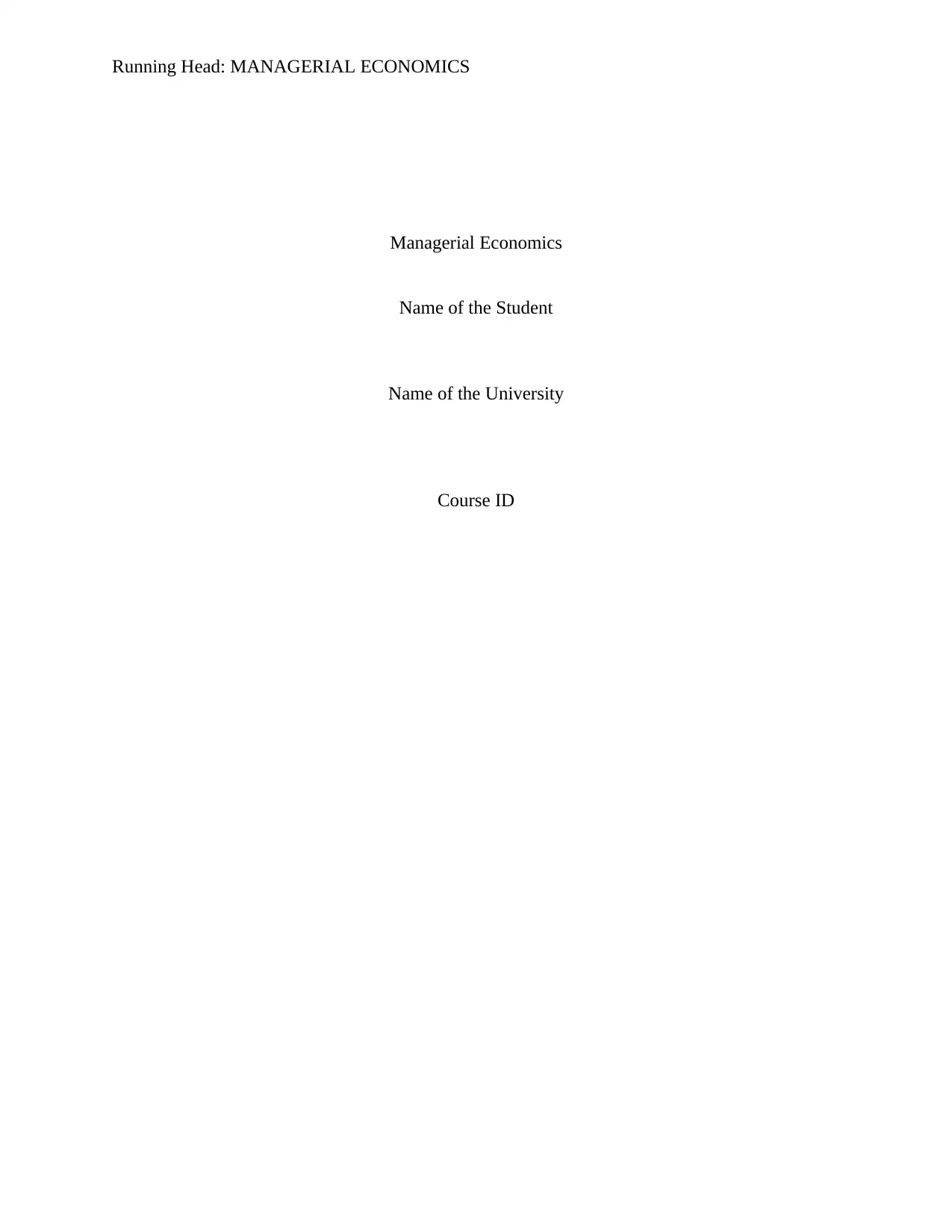
Running Head: MANAGERIAL ECONOMICS
Managerial Economics
Name of the Student
Name of the University
Course ID
Managerial Economics
Name of the Student
Name of the University
Course ID
Paraphrase This Document
Need a fresh take? Get an instant paraphrase of this document with our AI Paraphraser
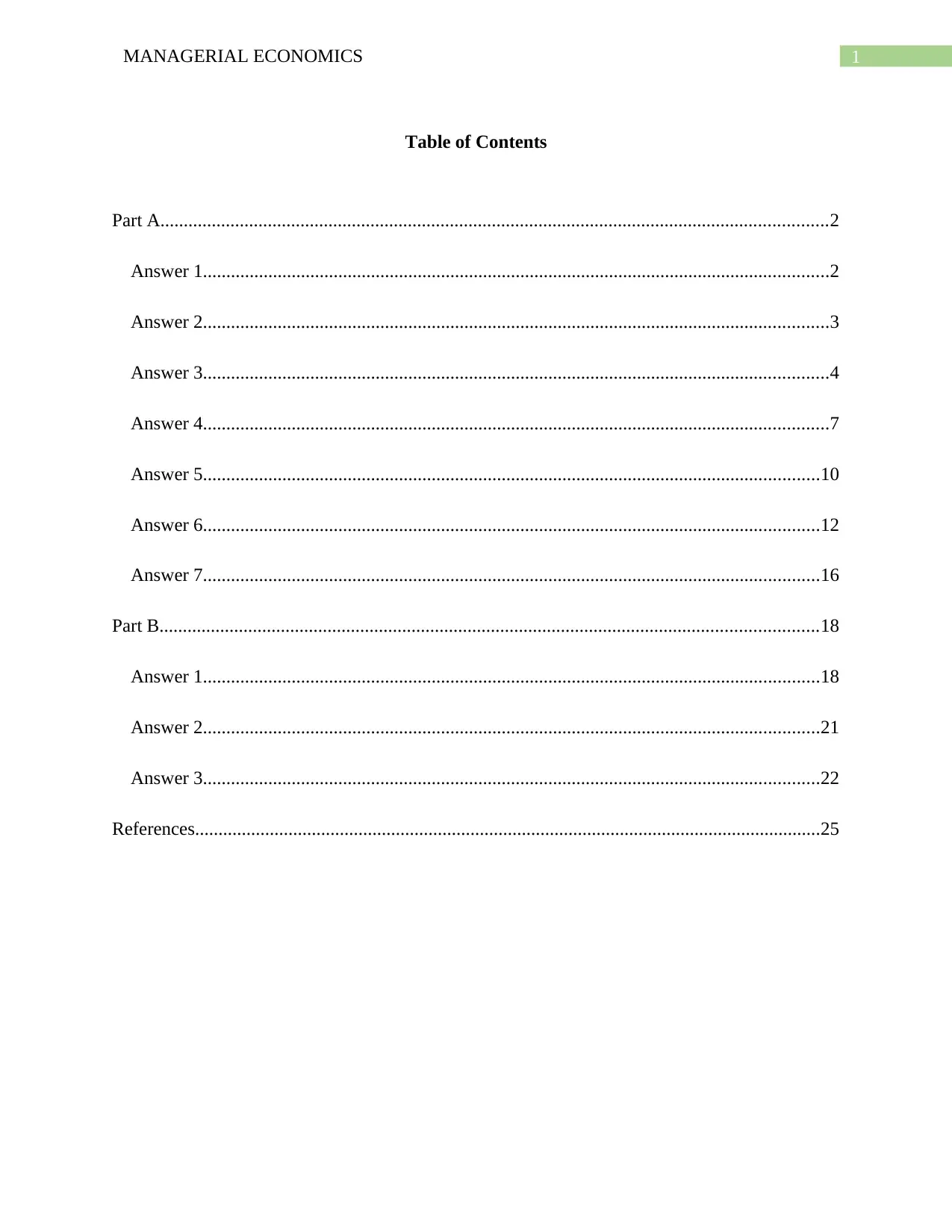
1MANAGERIAL ECONOMICS
Table of Contents
Part A...............................................................................................................................................2
Answer 1......................................................................................................................................2
Answer 2......................................................................................................................................3
Answer 3......................................................................................................................................4
Answer 4......................................................................................................................................7
Answer 5....................................................................................................................................10
Answer 6....................................................................................................................................12
Answer 7....................................................................................................................................16
Part B.............................................................................................................................................18
Answer 1....................................................................................................................................18
Answer 2....................................................................................................................................21
Answer 3....................................................................................................................................22
References......................................................................................................................................25
Table of Contents
Part A...............................................................................................................................................2
Answer 1......................................................................................................................................2
Answer 2......................................................................................................................................3
Answer 3......................................................................................................................................4
Answer 4......................................................................................................................................7
Answer 5....................................................................................................................................10
Answer 6....................................................................................................................................12
Answer 7....................................................................................................................................16
Part B.............................................................................................................................................18
Answer 1....................................................................................................................................18
Answer 2....................................................................................................................................21
Answer 3....................................................................................................................................22
References......................................................................................................................................25
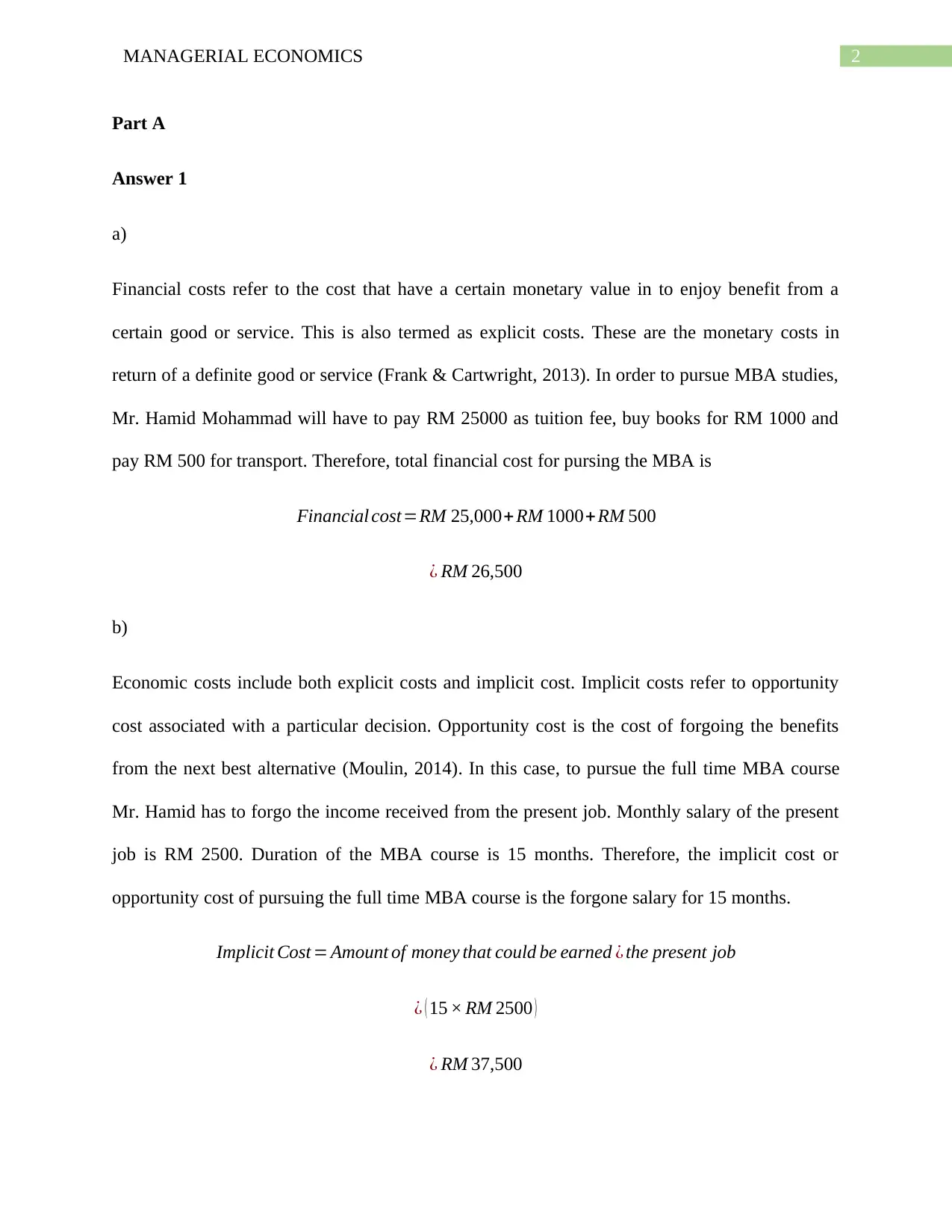
2MANAGERIAL ECONOMICS
Part A
Answer 1
a)
Financial costs refer to the cost that have a certain monetary value in to enjoy benefit from a
certain good or service. This is also termed as explicit costs. These are the monetary costs in
return of a definite good or service (Frank & Cartwright, 2013). In order to pursue MBA studies,
Mr. Hamid Mohammad will have to pay RM 25000 as tuition fee, buy books for RM 1000 and
pay RM 500 for transport. Therefore, total financial cost for pursing the MBA is
Financial cost=RM 25,000+ RM 1000+RM 500
¿ RM 26,500
b)
Economic costs include both explicit costs and implicit cost. Implicit costs refer to opportunity
cost associated with a particular decision. Opportunity cost is the cost of forgoing the benefits
from the next best alternative (Moulin, 2014). In this case, to pursue the full time MBA course
Mr. Hamid has to forgo the income received from the present job. Monthly salary of the present
job is RM 2500. Duration of the MBA course is 15 months. Therefore, the implicit cost or
opportunity cost of pursuing the full time MBA course is the forgone salary for 15 months.
Implicit Cost = Amount of money that could be earned ¿ the present job
¿ ( 15 × RM 2500 )
¿ RM 37,500
Part A
Answer 1
a)
Financial costs refer to the cost that have a certain monetary value in to enjoy benefit from a
certain good or service. This is also termed as explicit costs. These are the monetary costs in
return of a definite good or service (Frank & Cartwright, 2013). In order to pursue MBA studies,
Mr. Hamid Mohammad will have to pay RM 25000 as tuition fee, buy books for RM 1000 and
pay RM 500 for transport. Therefore, total financial cost for pursing the MBA is
Financial cost=RM 25,000+ RM 1000+RM 500
¿ RM 26,500
b)
Economic costs include both explicit costs and implicit cost. Implicit costs refer to opportunity
cost associated with a particular decision. Opportunity cost is the cost of forgoing the benefits
from the next best alternative (Moulin, 2014). In this case, to pursue the full time MBA course
Mr. Hamid has to forgo the income received from the present job. Monthly salary of the present
job is RM 2500. Duration of the MBA course is 15 months. Therefore, the implicit cost or
opportunity cost of pursuing the full time MBA course is the forgone salary for 15 months.
Implicit Cost = Amount of money that could be earned ¿ the present job
¿ ( 15 × RM 2500 )
¿ RM 37,500
⊘ This is a preview!⊘
Do you want full access?
Subscribe today to unlock all pages.

Trusted by 1+ million students worldwide
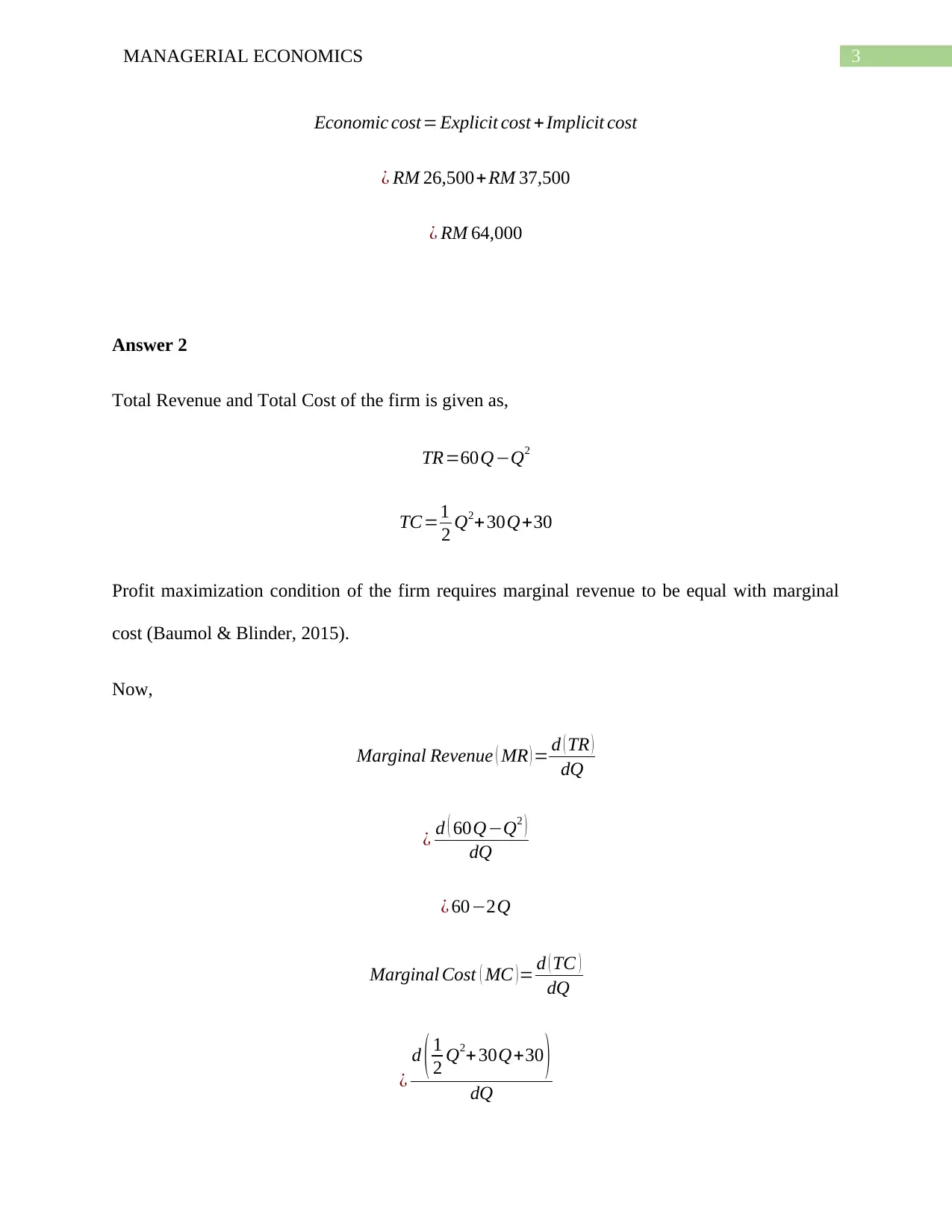
3MANAGERIAL ECONOMICS
Economic cost= Explicit cost + Implicit cost
¿ RM 26,500+ RM 37,500
¿ RM 64,000
Answer 2
Total Revenue and Total Cost of the firm is given as,
TR=60Q−Q2
TC=1
2 Q2+30Q+30
Profit maximization condition of the firm requires marginal revenue to be equal with marginal
cost (Baumol & Blinder, 2015).
Now,
Marginal Revenue ( MR ) = d ( TR )
dQ
¿ d ( 60Q−Q2 )
dQ
¿ 60−2Q
Marginal Cost ( MC ) = d ( TC )
dQ
¿
d ( 1
2 Q2+ 30Q+30 )
dQ
Economic cost= Explicit cost + Implicit cost
¿ RM 26,500+ RM 37,500
¿ RM 64,000
Answer 2
Total Revenue and Total Cost of the firm is given as,
TR=60Q−Q2
TC=1
2 Q2+30Q+30
Profit maximization condition of the firm requires marginal revenue to be equal with marginal
cost (Baumol & Blinder, 2015).
Now,
Marginal Revenue ( MR ) = d ( TR )
dQ
¿ d ( 60Q−Q2 )
dQ
¿ 60−2Q
Marginal Cost ( MC ) = d ( TC )
dQ
¿
d ( 1
2 Q2+ 30Q+30 )
dQ
Paraphrase This Document
Need a fresh take? Get an instant paraphrase of this document with our AI Paraphraser
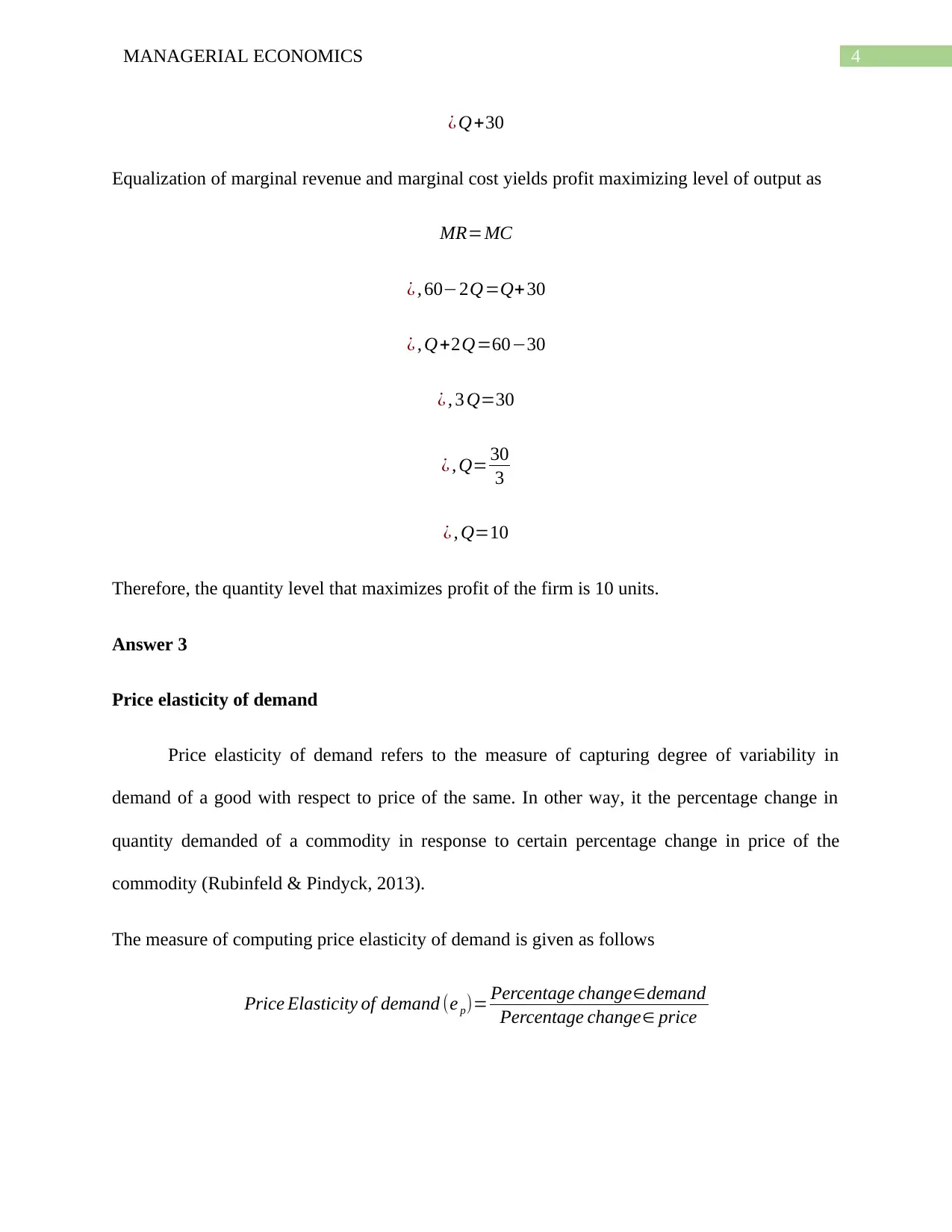
4MANAGERIAL ECONOMICS
¿ Q+30
Equalization of marginal revenue and marginal cost yields profit maximizing level of output as
MR=MC
¿ , 60−2Q=Q+ 30
¿ , Q+2Q=60−30
¿ , 3 Q=30
¿ , Q= 30
3
¿ , Q=10
Therefore, the quantity level that maximizes profit of the firm is 10 units.
Answer 3
Price elasticity of demand
Price elasticity of demand refers to the measure of capturing degree of variability in
demand of a good with respect to price of the same. In other way, it the percentage change in
quantity demanded of a commodity in response to certain percentage change in price of the
commodity (Rubinfeld & Pindyck, 2013).
The measure of computing price elasticity of demand is given as follows
Price Elasticity of demand (e p)= Percentage change∈demand
Percentage change∈ price
¿ Q+30
Equalization of marginal revenue and marginal cost yields profit maximizing level of output as
MR=MC
¿ , 60−2Q=Q+ 30
¿ , Q+2Q=60−30
¿ , 3 Q=30
¿ , Q= 30
3
¿ , Q=10
Therefore, the quantity level that maximizes profit of the firm is 10 units.
Answer 3
Price elasticity of demand
Price elasticity of demand refers to the measure of capturing degree of variability in
demand of a good with respect to price of the same. In other way, it the percentage change in
quantity demanded of a commodity in response to certain percentage change in price of the
commodity (Rubinfeld & Pindyck, 2013).
The measure of computing price elasticity of demand is given as follows
Price Elasticity of demand (e p)= Percentage change∈demand
Percentage change∈ price
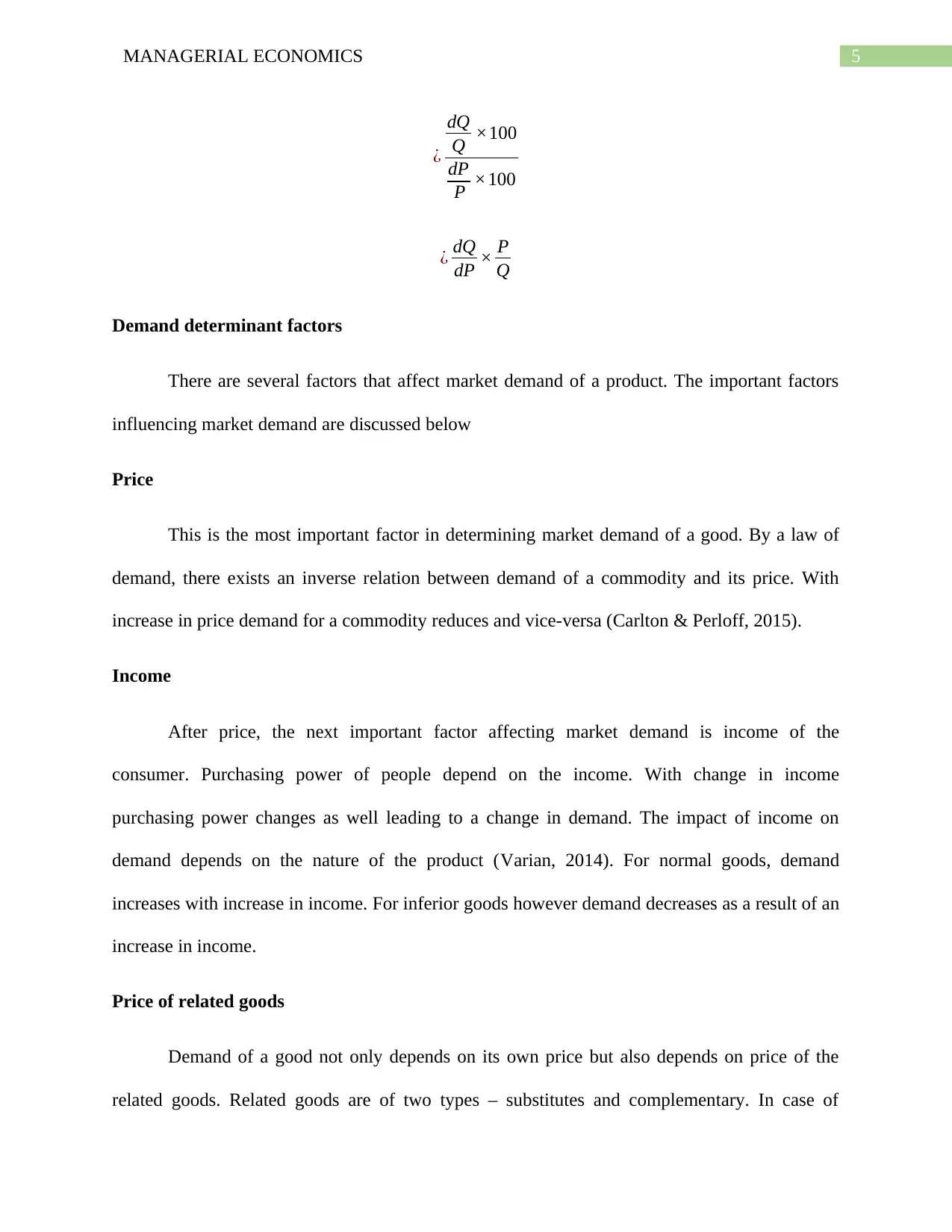
5MANAGERIAL ECONOMICS
¿
dQ
Q ×100
dP
P ×100
¿ dQ
dP × P
Q
Demand determinant factors
There are several factors that affect market demand of a product. The important factors
influencing market demand are discussed below
Price
This is the most important factor in determining market demand of a good. By a law of
demand, there exists an inverse relation between demand of a commodity and its price. With
increase in price demand for a commodity reduces and vice-versa (Carlton & Perloff, 2015).
Income
After price, the next important factor affecting market demand is income of the
consumer. Purchasing power of people depend on the income. With change in income
purchasing power changes as well leading to a change in demand. The impact of income on
demand depends on the nature of the product (Varian, 2014). For normal goods, demand
increases with increase in income. For inferior goods however demand decreases as a result of an
increase in income.
Price of related goods
Demand of a good not only depends on its own price but also depends on price of the
related goods. Related goods are of two types – substitutes and complementary. In case of
¿
dQ
Q ×100
dP
P ×100
¿ dQ
dP × P
Q
Demand determinant factors
There are several factors that affect market demand of a product. The important factors
influencing market demand are discussed below
Price
This is the most important factor in determining market demand of a good. By a law of
demand, there exists an inverse relation between demand of a commodity and its price. With
increase in price demand for a commodity reduces and vice-versa (Carlton & Perloff, 2015).
Income
After price, the next important factor affecting market demand is income of the
consumer. Purchasing power of people depend on the income. With change in income
purchasing power changes as well leading to a change in demand. The impact of income on
demand depends on the nature of the product (Varian, 2014). For normal goods, demand
increases with increase in income. For inferior goods however demand decreases as a result of an
increase in income.
Price of related goods
Demand of a good not only depends on its own price but also depends on price of the
related goods. Related goods are of two types – substitutes and complementary. In case of
⊘ This is a preview!⊘
Do you want full access?
Subscribe today to unlock all pages.

Trusted by 1+ million students worldwide
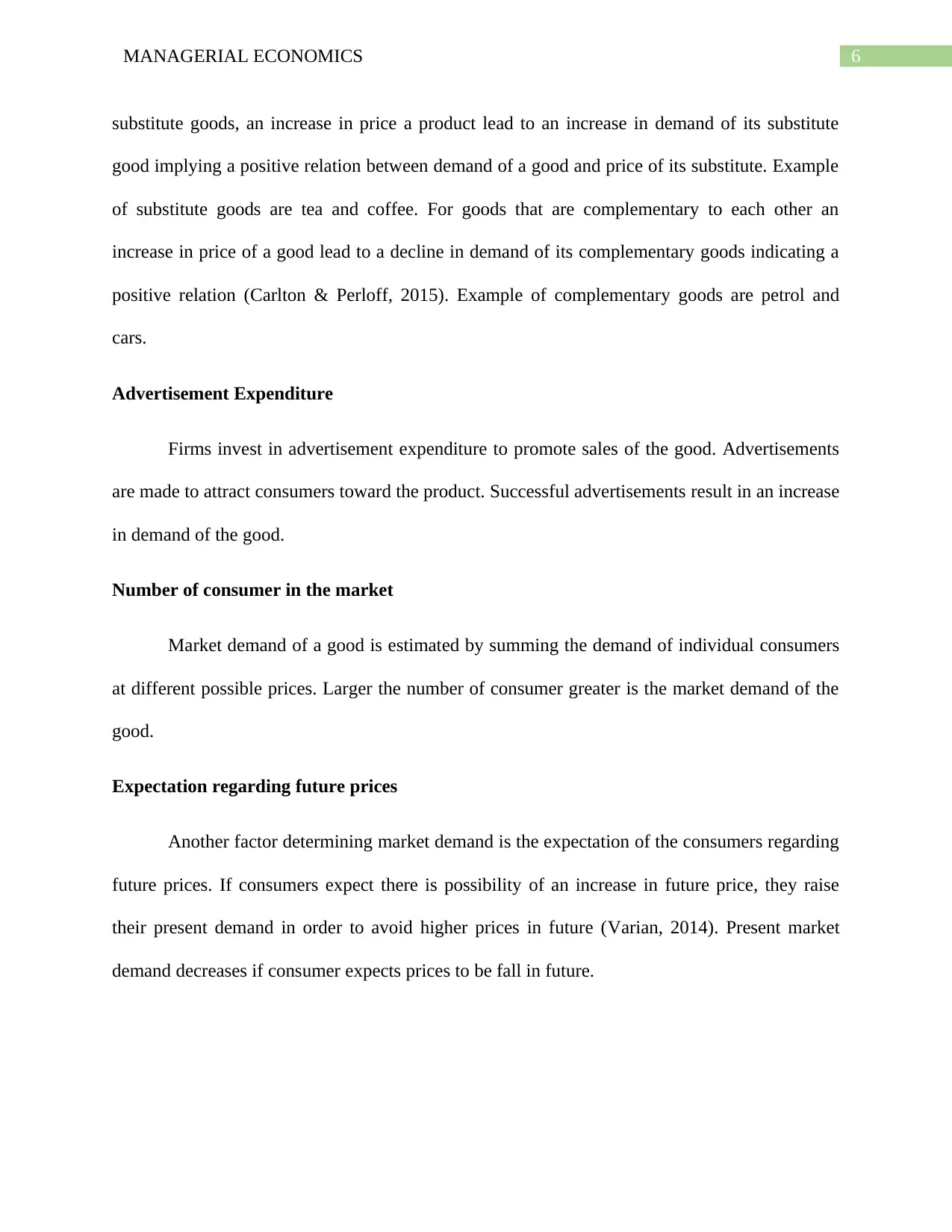
6MANAGERIAL ECONOMICS
substitute goods, an increase in price a product lead to an increase in demand of its substitute
good implying a positive relation between demand of a good and price of its substitute. Example
of substitute goods are tea and coffee. For goods that are complementary to each other an
increase in price of a good lead to a decline in demand of its complementary goods indicating a
positive relation (Carlton & Perloff, 2015). Example of complementary goods are petrol and
cars.
Advertisement Expenditure
Firms invest in advertisement expenditure to promote sales of the good. Advertisements
are made to attract consumers toward the product. Successful advertisements result in an increase
in demand of the good.
Number of consumer in the market
Market demand of a good is estimated by summing the demand of individual consumers
at different possible prices. Larger the number of consumer greater is the market demand of the
good.
Expectation regarding future prices
Another factor determining market demand is the expectation of the consumers regarding
future prices. If consumers expect there is possibility of an increase in future price, they raise
their present demand in order to avoid higher prices in future (Varian, 2014). Present market
demand decreases if consumer expects prices to be fall in future.
substitute goods, an increase in price a product lead to an increase in demand of its substitute
good implying a positive relation between demand of a good and price of its substitute. Example
of substitute goods are tea and coffee. For goods that are complementary to each other an
increase in price of a good lead to a decline in demand of its complementary goods indicating a
positive relation (Carlton & Perloff, 2015). Example of complementary goods are petrol and
cars.
Advertisement Expenditure
Firms invest in advertisement expenditure to promote sales of the good. Advertisements
are made to attract consumers toward the product. Successful advertisements result in an increase
in demand of the good.
Number of consumer in the market
Market demand of a good is estimated by summing the demand of individual consumers
at different possible prices. Larger the number of consumer greater is the market demand of the
good.
Expectation regarding future prices
Another factor determining market demand is the expectation of the consumers regarding
future prices. If consumers expect there is possibility of an increase in future price, they raise
their present demand in order to avoid higher prices in future (Varian, 2014). Present market
demand decreases if consumer expects prices to be fall in future.
Paraphrase This Document
Need a fresh take? Get an instant paraphrase of this document with our AI Paraphraser
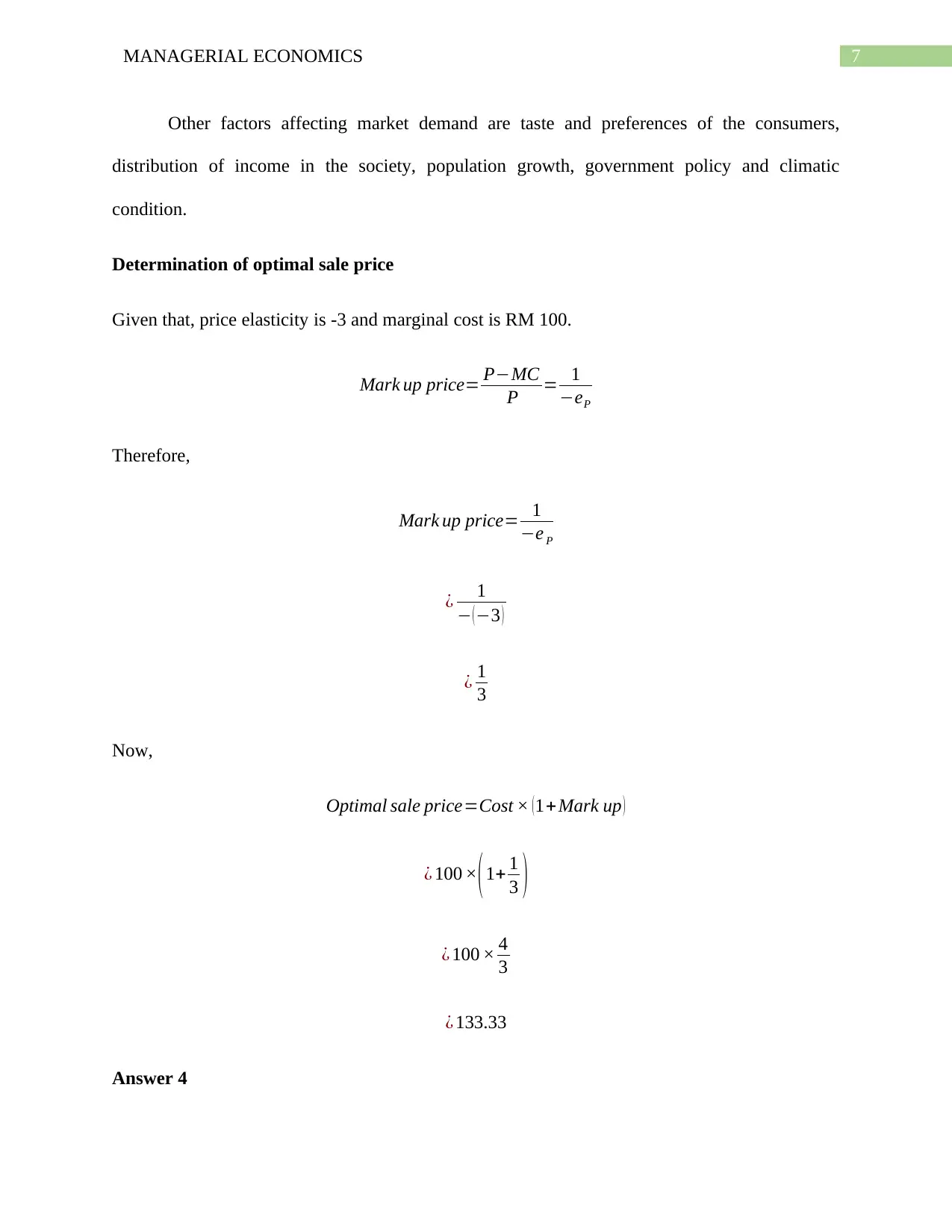
7MANAGERIAL ECONOMICS
Other factors affecting market demand are taste and preferences of the consumers,
distribution of income in the society, population growth, government policy and climatic
condition.
Determination of optimal sale price
Given that, price elasticity is -3 and marginal cost is RM 100.
Mark up price= P−MC
P = 1
−eP
Therefore,
Mark up price= 1
−e P
¿ 1
− ( −3 )
¿ 1
3
Now,
Optimal sale price=Cost × ( 1+Mark up )
¿ 100 × (1+ 1
3 )
¿ 100 × 4
3
¿ 133.33
Answer 4
Other factors affecting market demand are taste and preferences of the consumers,
distribution of income in the society, population growth, government policy and climatic
condition.
Determination of optimal sale price
Given that, price elasticity is -3 and marginal cost is RM 100.
Mark up price= P−MC
P = 1
−eP
Therefore,
Mark up price= 1
−e P
¿ 1
− ( −3 )
¿ 1
3
Now,
Optimal sale price=Cost × ( 1+Mark up )
¿ 100 × (1+ 1
3 )
¿ 100 × 4
3
¿ 133.33
Answer 4
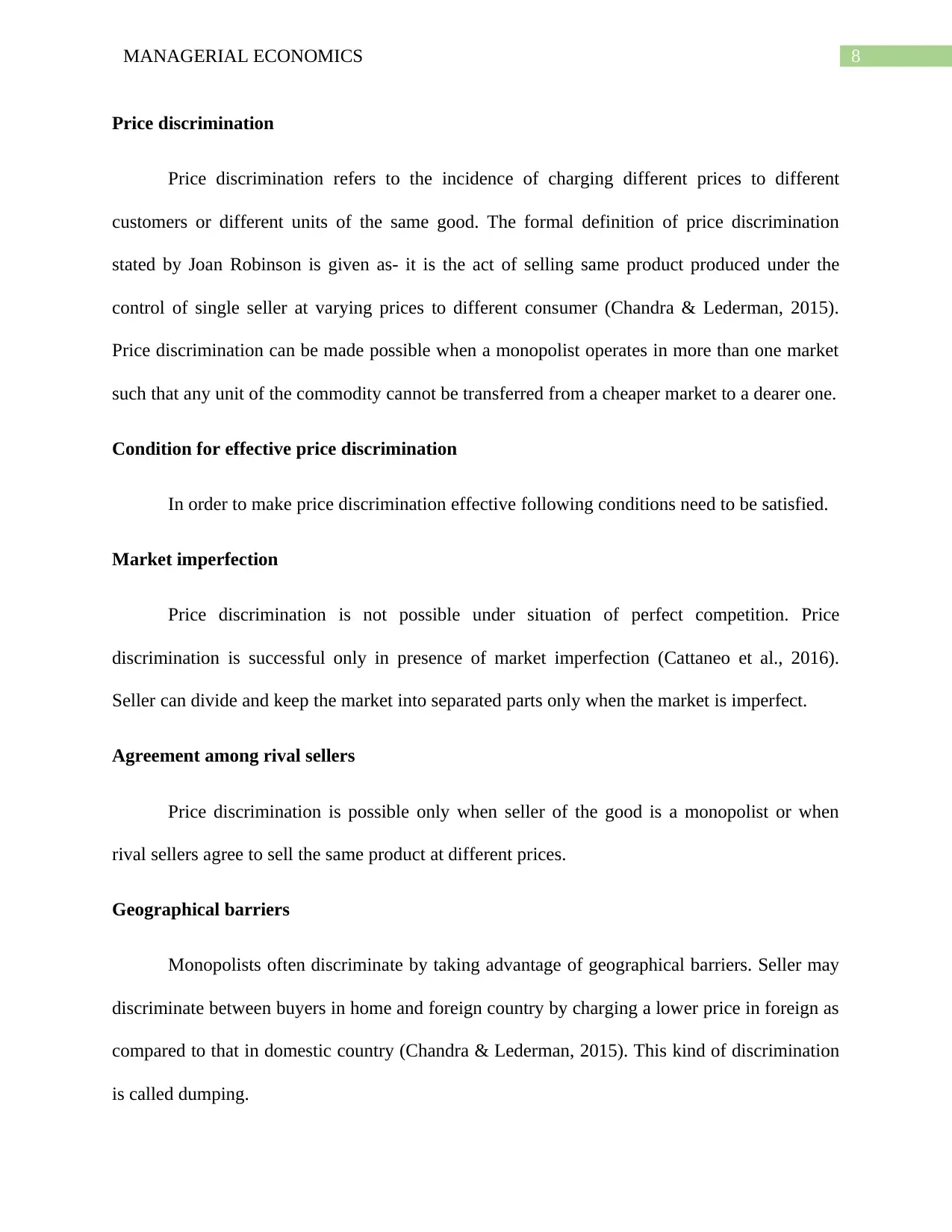
8MANAGERIAL ECONOMICS
Price discrimination
Price discrimination refers to the incidence of charging different prices to different
customers or different units of the same good. The formal definition of price discrimination
stated by Joan Robinson is given as- it is the act of selling same product produced under the
control of single seller at varying prices to different consumer (Chandra & Lederman, 2015).
Price discrimination can be made possible when a monopolist operates in more than one market
such that any unit of the commodity cannot be transferred from a cheaper market to a dearer one.
Condition for effective price discrimination
In order to make price discrimination effective following conditions need to be satisfied.
Market imperfection
Price discrimination is not possible under situation of perfect competition. Price
discrimination is successful only in presence of market imperfection (Cattaneo et al., 2016).
Seller can divide and keep the market into separated parts only when the market is imperfect.
Agreement among rival sellers
Price discrimination is possible only when seller of the good is a monopolist or when
rival sellers agree to sell the same product at different prices.
Geographical barriers
Monopolists often discriminate by taking advantage of geographical barriers. Seller may
discriminate between buyers in home and foreign country by charging a lower price in foreign as
compared to that in domestic country (Chandra & Lederman, 2015). This kind of discrimination
is called dumping.
Price discrimination
Price discrimination refers to the incidence of charging different prices to different
customers or different units of the same good. The formal definition of price discrimination
stated by Joan Robinson is given as- it is the act of selling same product produced under the
control of single seller at varying prices to different consumer (Chandra & Lederman, 2015).
Price discrimination can be made possible when a monopolist operates in more than one market
such that any unit of the commodity cannot be transferred from a cheaper market to a dearer one.
Condition for effective price discrimination
In order to make price discrimination effective following conditions need to be satisfied.
Market imperfection
Price discrimination is not possible under situation of perfect competition. Price
discrimination is successful only in presence of market imperfection (Cattaneo et al., 2016).
Seller can divide and keep the market into separated parts only when the market is imperfect.
Agreement among rival sellers
Price discrimination is possible only when seller of the good is a monopolist or when
rival sellers agree to sell the same product at different prices.
Geographical barriers
Monopolists often discriminate by taking advantage of geographical barriers. Seller may
discriminate between buyers in home and foreign country by charging a lower price in foreign as
compared to that in domestic country (Chandra & Lederman, 2015). This kind of discrimination
is called dumping.
⊘ This is a preview!⊘
Do you want full access?
Subscribe today to unlock all pages.

Trusted by 1+ million students worldwide
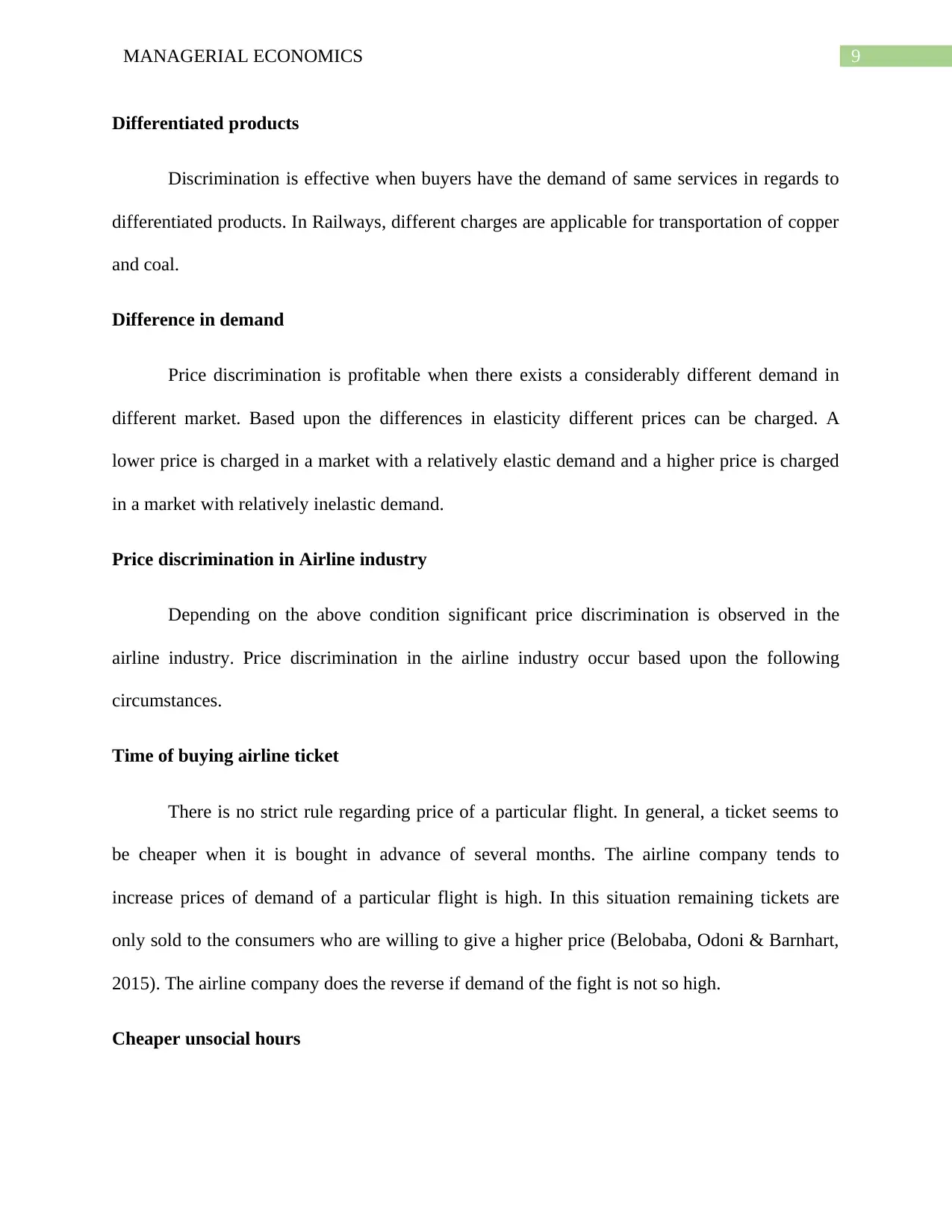
9MANAGERIAL ECONOMICS
Differentiated products
Discrimination is effective when buyers have the demand of same services in regards to
differentiated products. In Railways, different charges are applicable for transportation of copper
and coal.
Difference in demand
Price discrimination is profitable when there exists a considerably different demand in
different market. Based upon the differences in elasticity different prices can be charged. A
lower price is charged in a market with a relatively elastic demand and a higher price is charged
in a market with relatively inelastic demand.
Price discrimination in Airline industry
Depending on the above condition significant price discrimination is observed in the
airline industry. Price discrimination in the airline industry occur based upon the following
circumstances.
Time of buying airline ticket
There is no strict rule regarding price of a particular flight. In general, a ticket seems to
be cheaper when it is bought in advance of several months. The airline company tends to
increase prices of demand of a particular flight is high. In this situation remaining tickets are
only sold to the consumers who are willing to give a higher price (Belobaba, Odoni & Barnhart,
2015). The airline company does the reverse if demand of the fight is not so high.
Cheaper unsocial hours
Differentiated products
Discrimination is effective when buyers have the demand of same services in regards to
differentiated products. In Railways, different charges are applicable for transportation of copper
and coal.
Difference in demand
Price discrimination is profitable when there exists a considerably different demand in
different market. Based upon the differences in elasticity different prices can be charged. A
lower price is charged in a market with a relatively elastic demand and a higher price is charged
in a market with relatively inelastic demand.
Price discrimination in Airline industry
Depending on the above condition significant price discrimination is observed in the
airline industry. Price discrimination in the airline industry occur based upon the following
circumstances.
Time of buying airline ticket
There is no strict rule regarding price of a particular flight. In general, a ticket seems to
be cheaper when it is bought in advance of several months. The airline company tends to
increase prices of demand of a particular flight is high. In this situation remaining tickets are
only sold to the consumers who are willing to give a higher price (Belobaba, Odoni & Barnhart,
2015). The airline company does the reverse if demand of the fight is not so high.
Cheaper unsocial hours
Paraphrase This Document
Need a fresh take? Get an instant paraphrase of this document with our AI Paraphraser
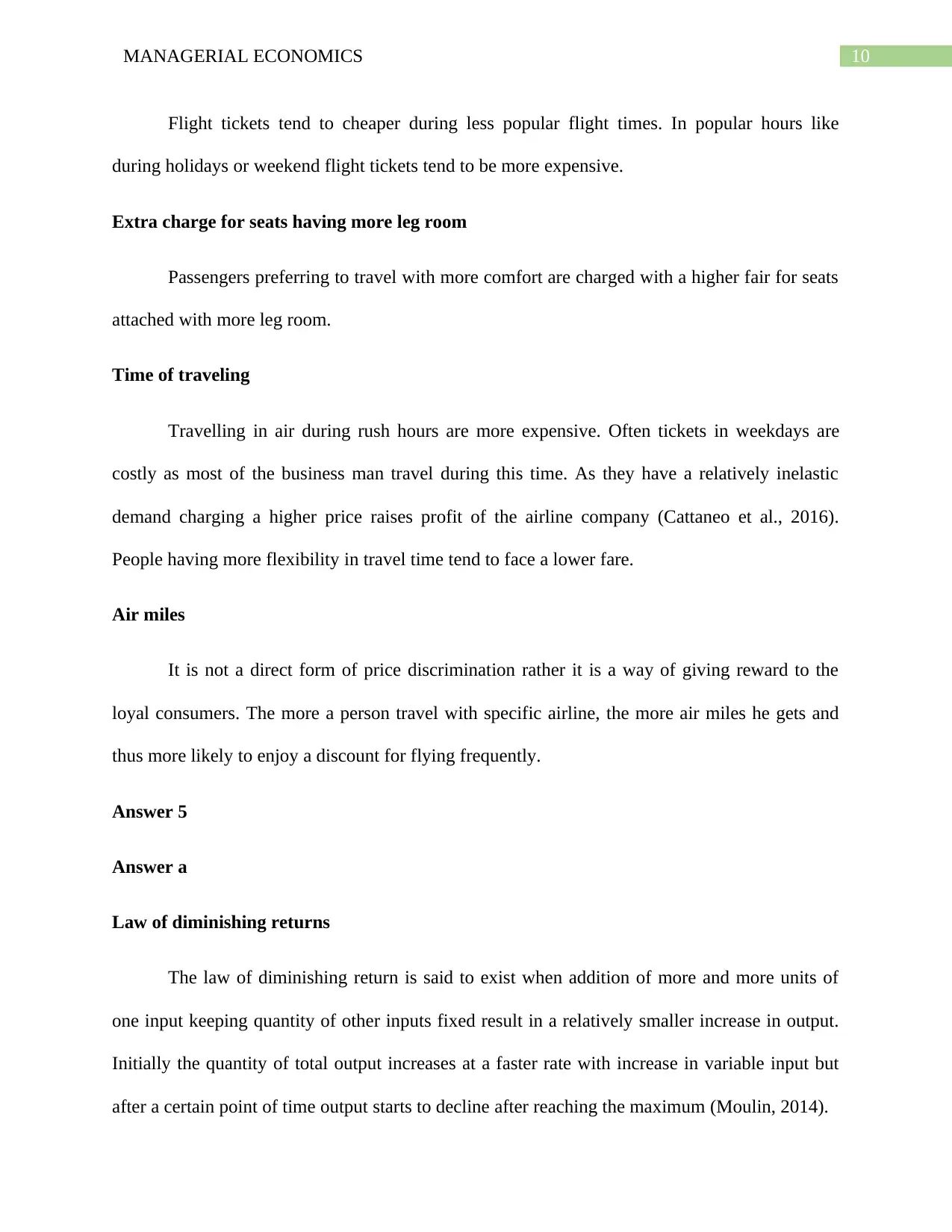
10MANAGERIAL ECONOMICS
Flight tickets tend to cheaper during less popular flight times. In popular hours like
during holidays or weekend flight tickets tend to be more expensive.
Extra charge for seats having more leg room
Passengers preferring to travel with more comfort are charged with a higher fair for seats
attached with more leg room.
Time of traveling
Travelling in air during rush hours are more expensive. Often tickets in weekdays are
costly as most of the business man travel during this time. As they have a relatively inelastic
demand charging a higher price raises profit of the airline company (Cattaneo et al., 2016).
People having more flexibility in travel time tend to face a lower fare.
Air miles
It is not a direct form of price discrimination rather it is a way of giving reward to the
loyal consumers. The more a person travel with specific airline, the more air miles he gets and
thus more likely to enjoy a discount for flying frequently.
Answer 5
Answer a
Law of diminishing returns
The law of diminishing return is said to exist when addition of more and more units of
one input keeping quantity of other inputs fixed result in a relatively smaller increase in output.
Initially the quantity of total output increases at a faster rate with increase in variable input but
after a certain point of time output starts to decline after reaching the maximum (Moulin, 2014).
Flight tickets tend to cheaper during less popular flight times. In popular hours like
during holidays or weekend flight tickets tend to be more expensive.
Extra charge for seats having more leg room
Passengers preferring to travel with more comfort are charged with a higher fair for seats
attached with more leg room.
Time of traveling
Travelling in air during rush hours are more expensive. Often tickets in weekdays are
costly as most of the business man travel during this time. As they have a relatively inelastic
demand charging a higher price raises profit of the airline company (Cattaneo et al., 2016).
People having more flexibility in travel time tend to face a lower fare.
Air miles
It is not a direct form of price discrimination rather it is a way of giving reward to the
loyal consumers. The more a person travel with specific airline, the more air miles he gets and
thus more likely to enjoy a discount for flying frequently.
Answer 5
Answer a
Law of diminishing returns
The law of diminishing return is said to exist when addition of more and more units of
one input keeping quantity of other inputs fixed result in a relatively smaller increase in output.
Initially the quantity of total output increases at a faster rate with increase in variable input but
after a certain point of time output starts to decline after reaching the maximum (Moulin, 2014).
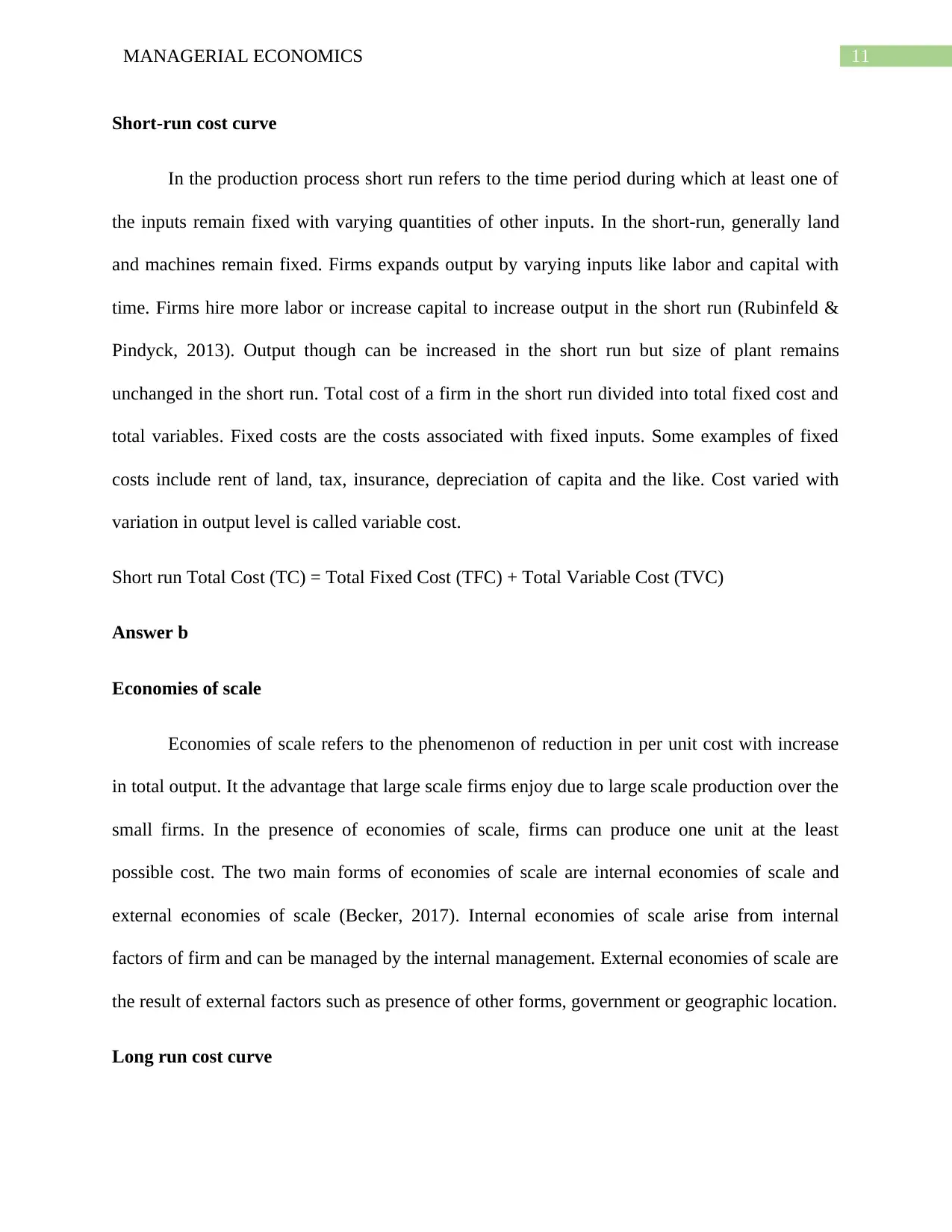
11MANAGERIAL ECONOMICS
Short-run cost curve
In the production process short run refers to the time period during which at least one of
the inputs remain fixed with varying quantities of other inputs. In the short-run, generally land
and machines remain fixed. Firms expands output by varying inputs like labor and capital with
time. Firms hire more labor or increase capital to increase output in the short run (Rubinfeld &
Pindyck, 2013). Output though can be increased in the short run but size of plant remains
unchanged in the short run. Total cost of a firm in the short run divided into total fixed cost and
total variables. Fixed costs are the costs associated with fixed inputs. Some examples of fixed
costs include rent of land, tax, insurance, depreciation of capita and the like. Cost varied with
variation in output level is called variable cost.
Short run Total Cost (TC) = Total Fixed Cost (TFC) + Total Variable Cost (TVC)
Answer b
Economies of scale
Economies of scale refers to the phenomenon of reduction in per unit cost with increase
in total output. It the advantage that large scale firms enjoy due to large scale production over the
small firms. In the presence of economies of scale, firms can produce one unit at the least
possible cost. The two main forms of economies of scale are internal economies of scale and
external economies of scale (Becker, 2017). Internal economies of scale arise from internal
factors of firm and can be managed by the internal management. External economies of scale are
the result of external factors such as presence of other forms, government or geographic location.
Long run cost curve
Short-run cost curve
In the production process short run refers to the time period during which at least one of
the inputs remain fixed with varying quantities of other inputs. In the short-run, generally land
and machines remain fixed. Firms expands output by varying inputs like labor and capital with
time. Firms hire more labor or increase capital to increase output in the short run (Rubinfeld &
Pindyck, 2013). Output though can be increased in the short run but size of plant remains
unchanged in the short run. Total cost of a firm in the short run divided into total fixed cost and
total variables. Fixed costs are the costs associated with fixed inputs. Some examples of fixed
costs include rent of land, tax, insurance, depreciation of capita and the like. Cost varied with
variation in output level is called variable cost.
Short run Total Cost (TC) = Total Fixed Cost (TFC) + Total Variable Cost (TVC)
Answer b
Economies of scale
Economies of scale refers to the phenomenon of reduction in per unit cost with increase
in total output. It the advantage that large scale firms enjoy due to large scale production over the
small firms. In the presence of economies of scale, firms can produce one unit at the least
possible cost. The two main forms of economies of scale are internal economies of scale and
external economies of scale (Becker, 2017). Internal economies of scale arise from internal
factors of firm and can be managed by the internal management. External economies of scale are
the result of external factors such as presence of other forms, government or geographic location.
Long run cost curve
⊘ This is a preview!⊘
Do you want full access?
Subscribe today to unlock all pages.

Trusted by 1+ million students worldwide
1 out of 29
Related Documents
Your All-in-One AI-Powered Toolkit for Academic Success.
+13062052269
info@desklib.com
Available 24*7 on WhatsApp / Email
![[object Object]](/_next/static/media/star-bottom.7253800d.svg)
Unlock your academic potential
Copyright © 2020–2025 A2Z Services. All Rights Reserved. Developed and managed by ZUCOL.





